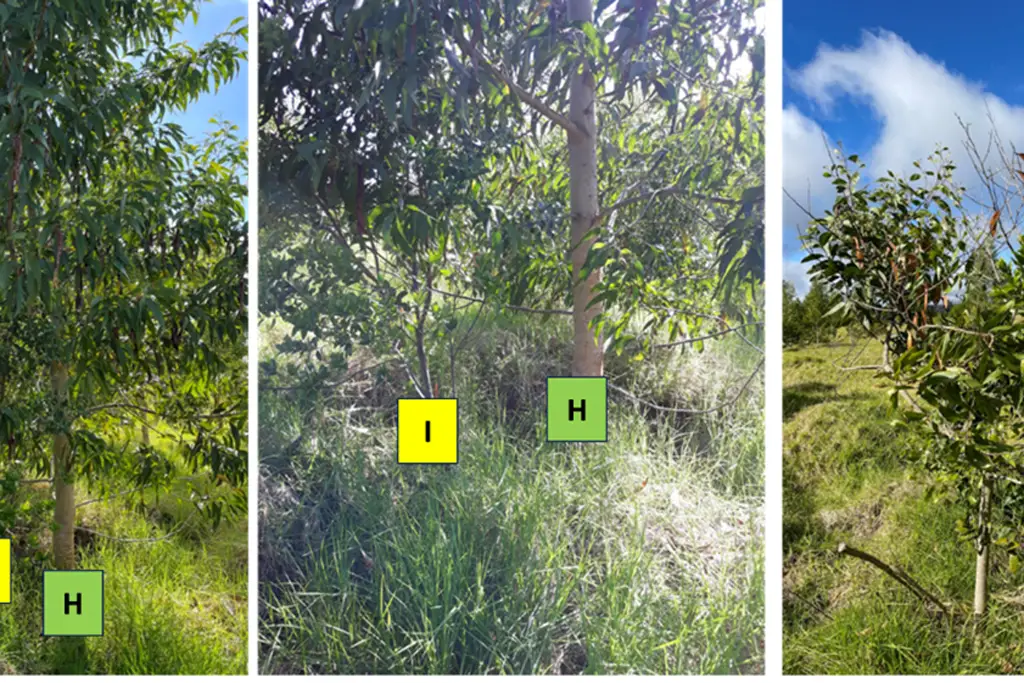Background / justification
Recovering populations of sandalwood (ʻiliahi) is a priority for biodiversity conservation in Hawaiian tropical dry forests. Two previous field studies on Hawaiʻi Island have been initiated to explore planting designs for reforestation of S. paniculatum (ʻiliahi) and host species. In the first study, ʻiliahi seedlings were underplanted in a 10-yr-old koa plantation. Seedling survival was >95% and average seedling height and diameter growth were 40 cm and 4.3 mm, respectively in the first year after planting (Thyroff et al. 2022). Seedling photosynthesis and growth after three years were positively related to canopy openness (Thyroff et al. 2024). ʻIliahi seems healthier and better growth when is surrounded by more hosts (Figure 1). This suggests parasitism and competition were both occurring and strongly affecting performance of ʻiliahi. It also suggests that pre-establishing a host plant can improve both ʻiliahi seedling performance and the continued survival and vigor of the host.
Another study is related to the host suitability evaluation wherein ʻiliahi seedlings were outplanted simultaneously with one of two native woody host species: Dodonaea viscosa (ʻaʻaliʻi) and Acacia koa Gray. (koa) (Thyroff et al., 2023). Establishing ʻiliahi closer to koa provided better survival, height, and basal stem diameter growth. Moreover, field observation after initial growth periods suggested three possibilities of comparative growth between sandalwood and the host: (a) both host and ʻiliahi had good growth; (b) the host exhibited better growth than ʻiliahi; and (c) ʻiliahi showed better growth than the host (Figure 2). This suggests that the host does not always facilitate ʻiliahi establishment; there may also be a significant competitive interaction that is not fully mitigated by parasitism. Results from this early field study suggest a high level of variation among ʻiliahi-host seedling pairs in parasitic resource transfer and relative growth during the first one to three years.
Although the host plays an important role as a resource provider for ʻiliahi, competition between the host and ʻiliahi also occurs, and these two interactions may influence each other. There may be a threshold of host density or proximity to ensure ʻiliahi seedling establishment, and host species may have a threshold tolerance to root parasitism. The limiting factors that affect these interactions are still unknown and may vary by host species. Multiple hosts are likely required to support long-term survival and growth of ʻiliahi, but the suitable or optimal species composition and spacing are unknown. Further investigation is required to address several questions, including:
- What is the balance competition between ʻiliahi and host plants in controlling facilitation and parasitism among them and the associated impact on the growth of ʻiliahi and the host?
- How do plant species composition and host type abundance affect this balance and plant growth?
- Can limiting factors be identified that influence the interaction between host and ʻiliahi and their impact on growth?
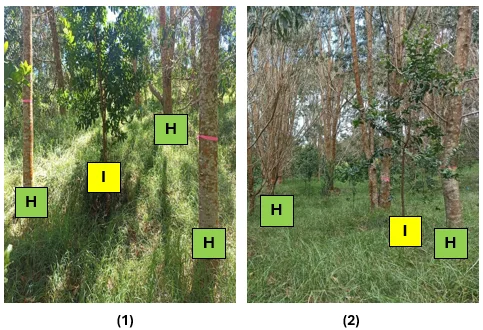
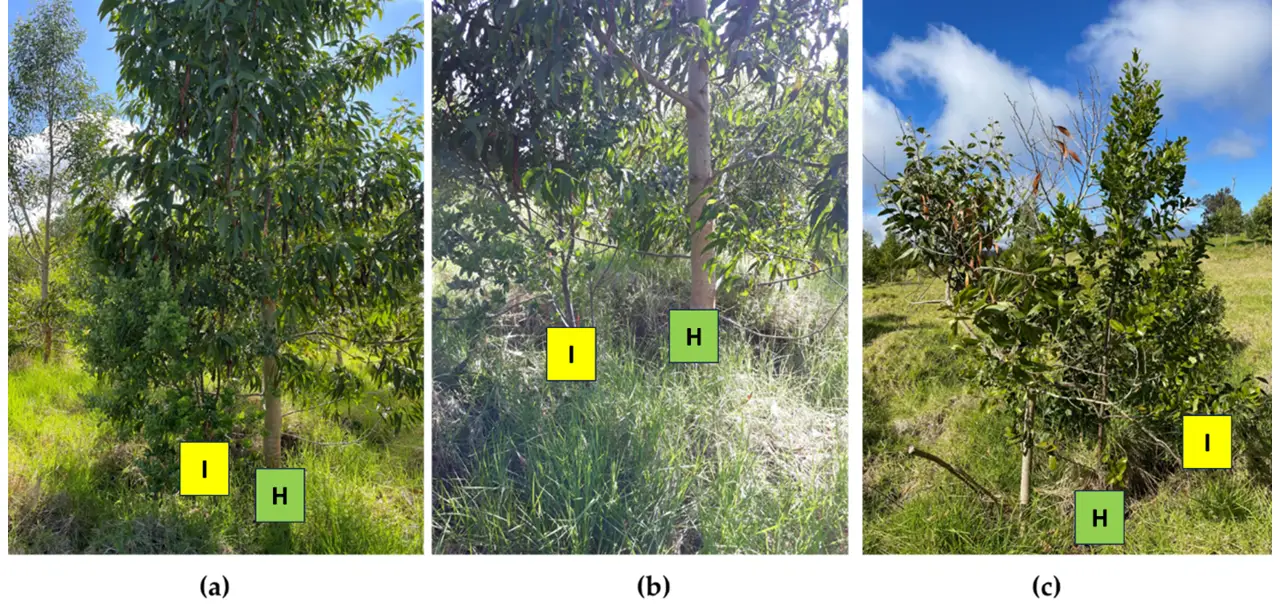
Project objectives
- to estimate the relative strengths of competition, facilitation, and parasitism among ʻiliahi and host plants
- to quantify the optimum ʻiliahi-host plant ratio in balancing competition, facilitation, and parasitism among ʻiliahi and hosts
- to measure differences in resource availability in different combinations of plant basal area, species composition, and ʻiliahi:host ratios as potentially limiting factors for the growth of ʻiliahi and host plants.
Approach
Plant Competition
The first project aims to estimate the balance of competition, facilitation, parasitism among underplanted ʻiliahi saplings and overstory koa trees. Shading by overstory koa trees will limit growth of ʻiliahi as well as parasitic resource transfer of water and nutrients from koa since ʻiliahi has a range of threshold tolerance to shade level. We divided this site into a grid of 20×20 m plots (Figure 3). It was designed to obtain a forest community structure from the combination of surviving ʻiliahi and koa. Plots naturally varied in the number and size of ʻiliahi and koa due to the variation of survival and growth for both species. Stem diameter at breast height (DBH) and tree height (H) were used as parameters to assess the growth of koa as the host plant. Growth of ʻiliahi was measured based on ground-line stem diameter (d), plant height (h), and crown radius (cr). Plot-basal area was assumed as the indicator of competition at the stand level, while facilitation and parasitism were estimated using mixed-species growth models based on the relative growth of each species across different ʻiliahi-host plant ratio.
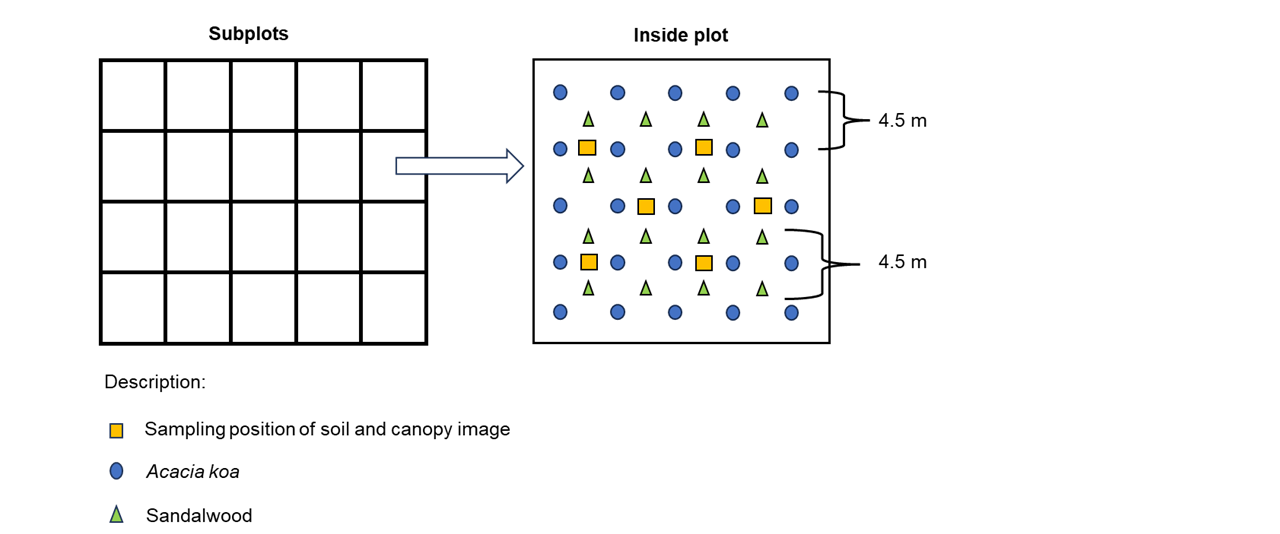
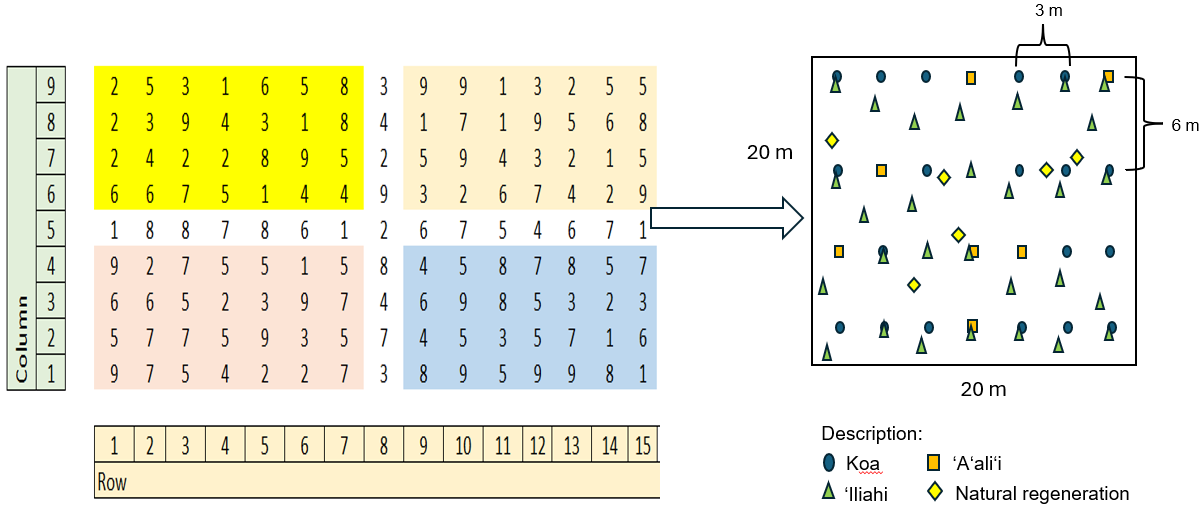
ʻIliahi-Host Ratio
The second project aims to quantify the optimum ʻiliahi-host plant ratio in balancing competition, facilitation, and parasitism among ʻiliahi and host plants in mixed stands. We evaluted the influence of stand composition and host abundance on ʻiliahi and host growth. As with the underplanting experiment, we expected that 5 years after outplanting, the saplings in this site were large enough to be interacting across experimental units within and between rows. This provided an opportunity to investigate the plant interactions at a stand levels in plot-based experimental units rather than ‘iliahi-host pairs. There has been mortality of some plants, which differs by treatment (Thyroff et al. 2023), as well as natural regeneration of koa and seedlings of other woody plants. To address these larger scale interactions, we splited the experimental site into adjancent 20×20 m plots that each contain four of the original ʻiliahi-host experimental units within four coloumns and seven rows (Figure 4). Plant composition varied among plots depending on the combination of previous treatments, plant mortality, and plant regeneration. Ground-line diameter (d) and plant height (h) were used to evaluate the growth of all woody plants inside plot. For koa saplings with a height >3 m, diameter was measured at breast height (~1.3 m). Foliar nutrients concentration was also recorded for ʻiliahi only.
Factors Limiting ʻIliahi Growth
The third project aims to identify factors limiting planted ʻiliahi growth in Hawaiian tropical dry forests. It addressed the important silvicultural aspects that should be considered to support ʻiliahi reforestation. This project also synthesized the previous two studies about the effectiveness of different reforestaion strategies to accelerate ʻiliahi recovery in the natural habitat. Data from the first and second projects were re-organized to develop a structural model using path analysis (Figure 5). This method combined various mathematical expressions, computer algorithms, and statistical approaches to describe the relationship among variables. It could generate a coefficient that denoted the relative contribution of a specific aspect on the behavior of a particular object (Table 1). It also provided a quantitative indicator of the relative influence of various biotic and abiotic factors affecting ʻiliahi growth.
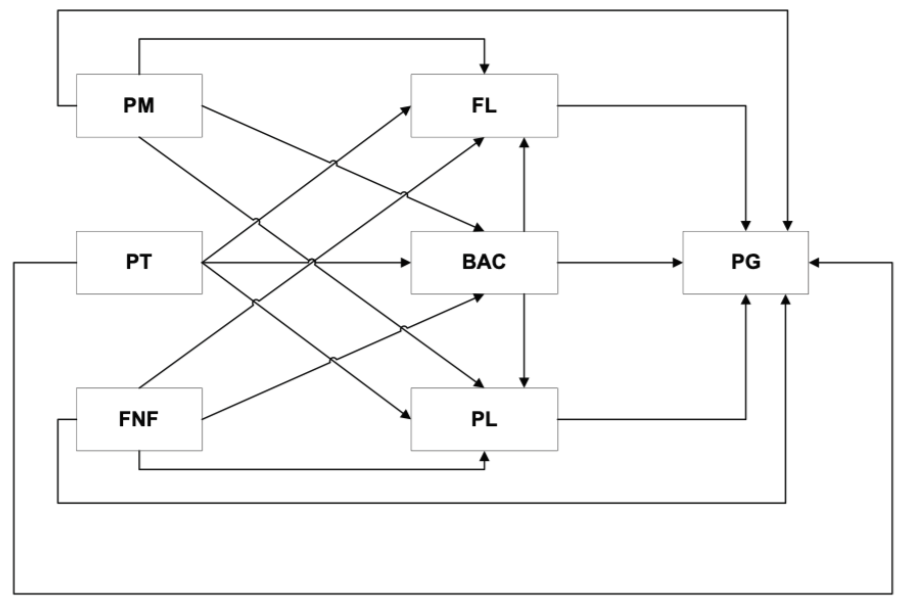

Key findings / accomplishments
Plant Competition
Competition significantly affected the growth of ʻiliahi and koa but their response were substantially different. Koa growth decreased with increased competition, while ʻiliahi growth increased with competition before declining at basal area > 26 m2 ha-1(Figure 6). ʻIliahi showed an asymetric response to competition which confirmed a trade-off between light requirements and root parasitic connections. Higher competition also increased facilitation but mitigated parasitism (Figure 7). Facilitation and parasitism were more important for growth of ʻiliahi, but competition seems to become the driving factor the trade-off between facilitation and parasitism (Figure 8). Foliar %N of ʻiliahi significantly positively correlated with competition and facilitation and negatively correlated with parasitism (Figure 9). Diameter and height of ʻiliahi positively correlated with foliar %N, while diameter of koa negatively correlated with foliar %N (Figure 9). The importance of facilitation and parasitism are balanced at a moderate level of competition (Figure 10). This corresponds to the highest growth of ʻiliahi but allowed for adequate growth of koa.
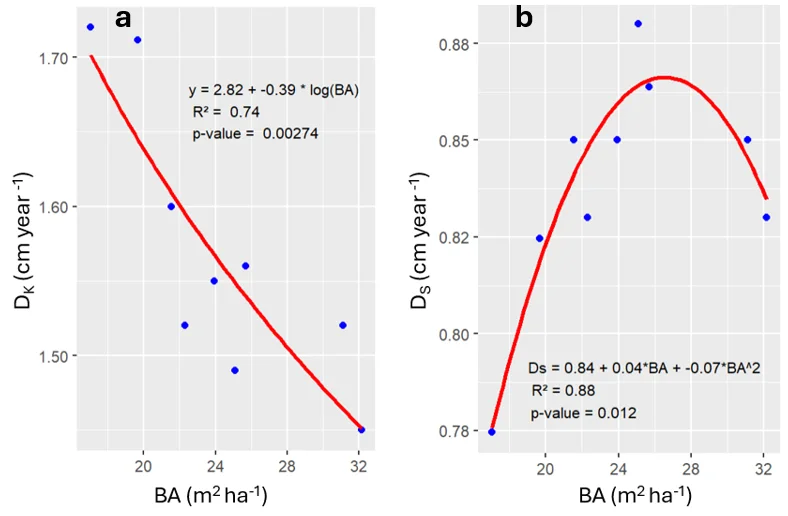
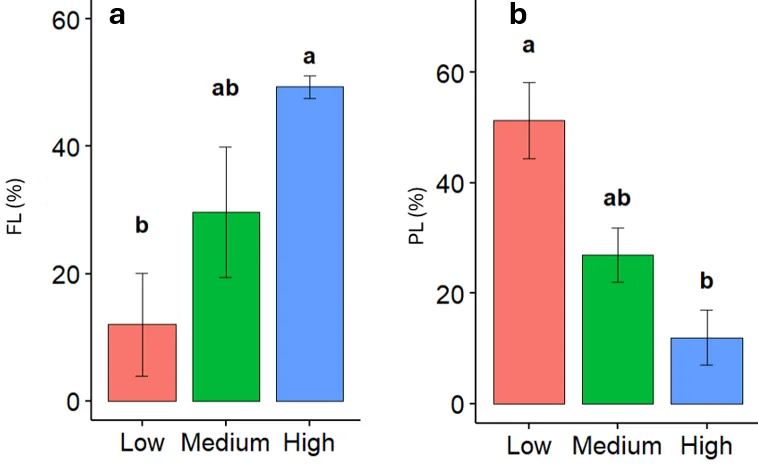
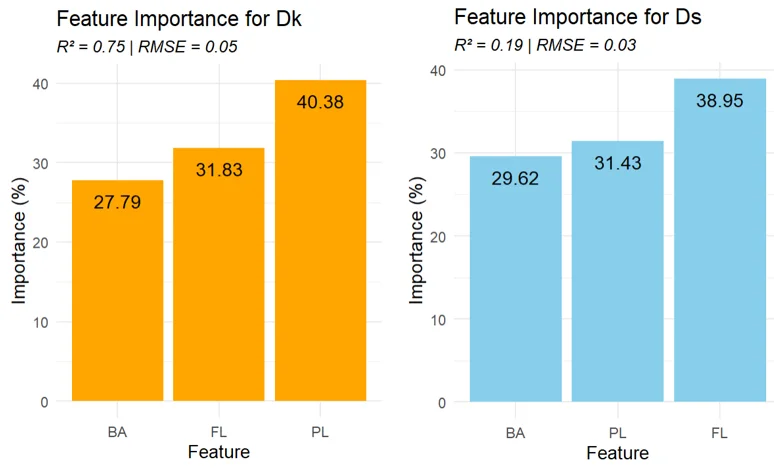
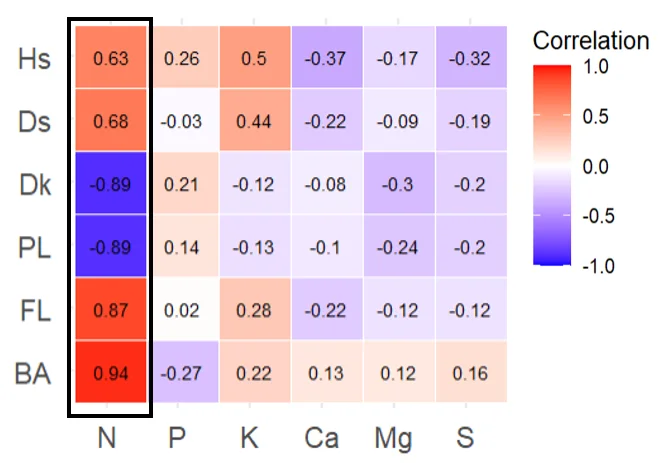
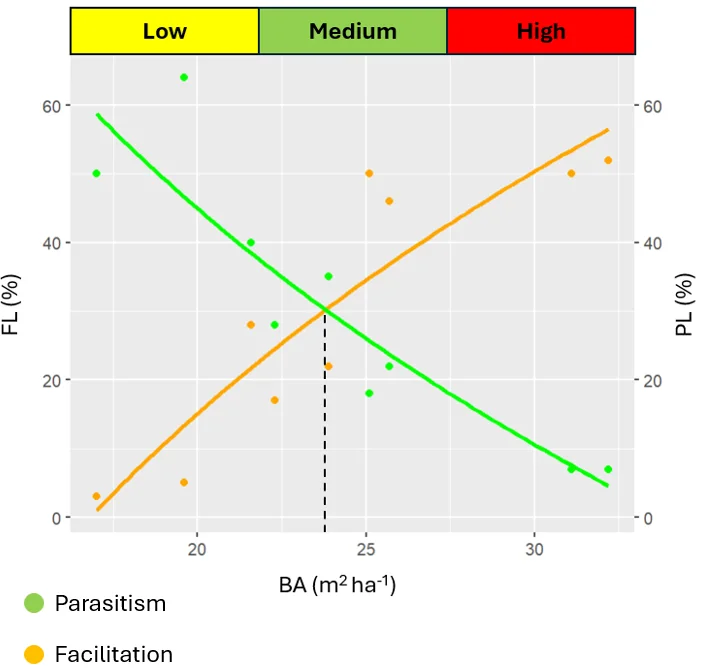
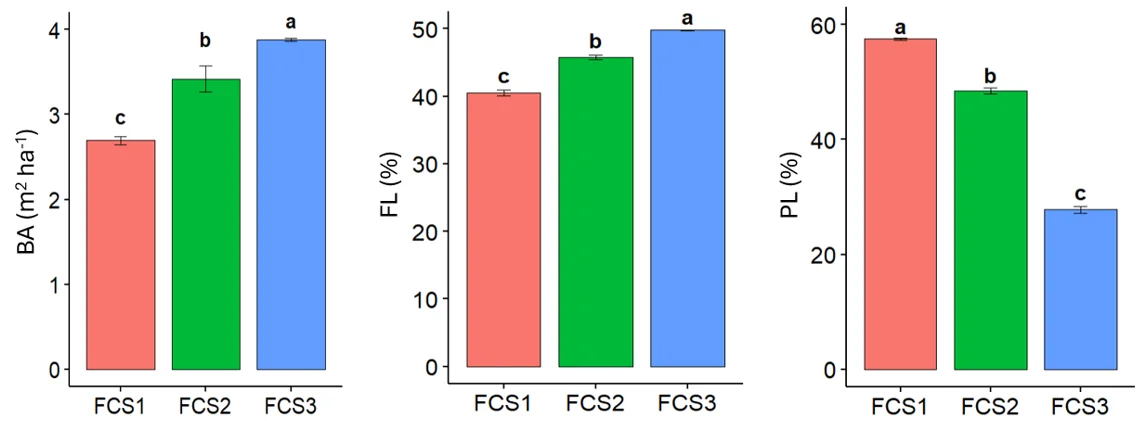
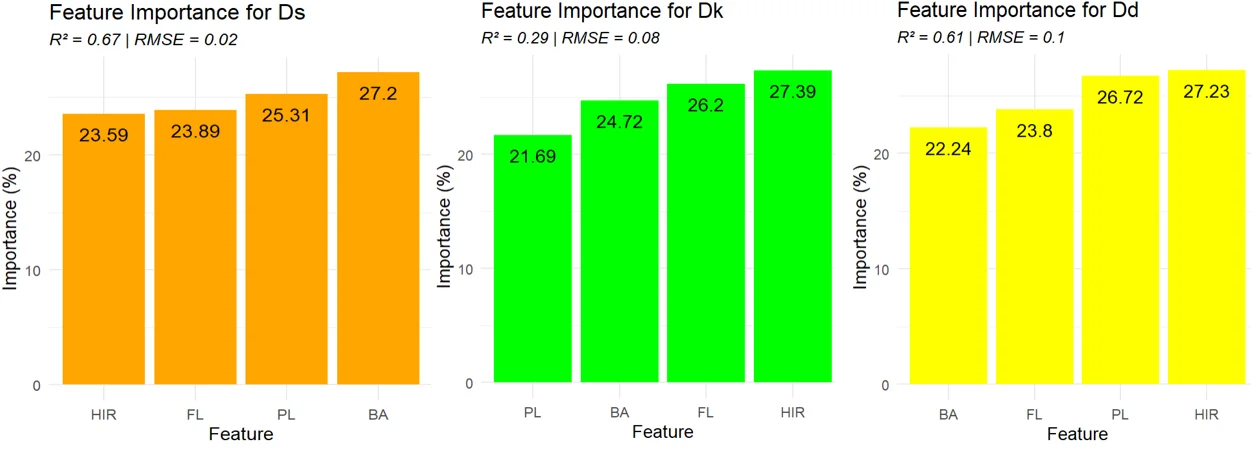
ʻIliahi-Host Ratio
Three categories of forest community structure (FCS) were recorded based on the different ʻiliahi-host plant ratio: FCS1 (host<ʻiliahi), FCS2 (host=ʻiliahi), and FCS3 (host>ʻiliahi). Different FCS significantly resulted distinguished growth of ʻiliahi and host (Table 2). ʻIliahi showed better growth when host was more abundance. Increasing host-to-‘iliahi ratio significantly increased competition and facilitation but descreased parasitism (Figure 11). Foliar %N of ‘iliahi also increased with increasing host abundance but foliar %K decreased (Table 3). Competition had the greatest effect on the diameter growth of ‘iliahi, while host-to-‘iliahi ratio had the highest effect on the diameter growth of host species (Figure 12). FCS3 (host>’iliahi) provided best growth for all species with an optimum host-to-‘iliahi ratio of 2:1 to balanced facilitation and parasitism (Figure 13).

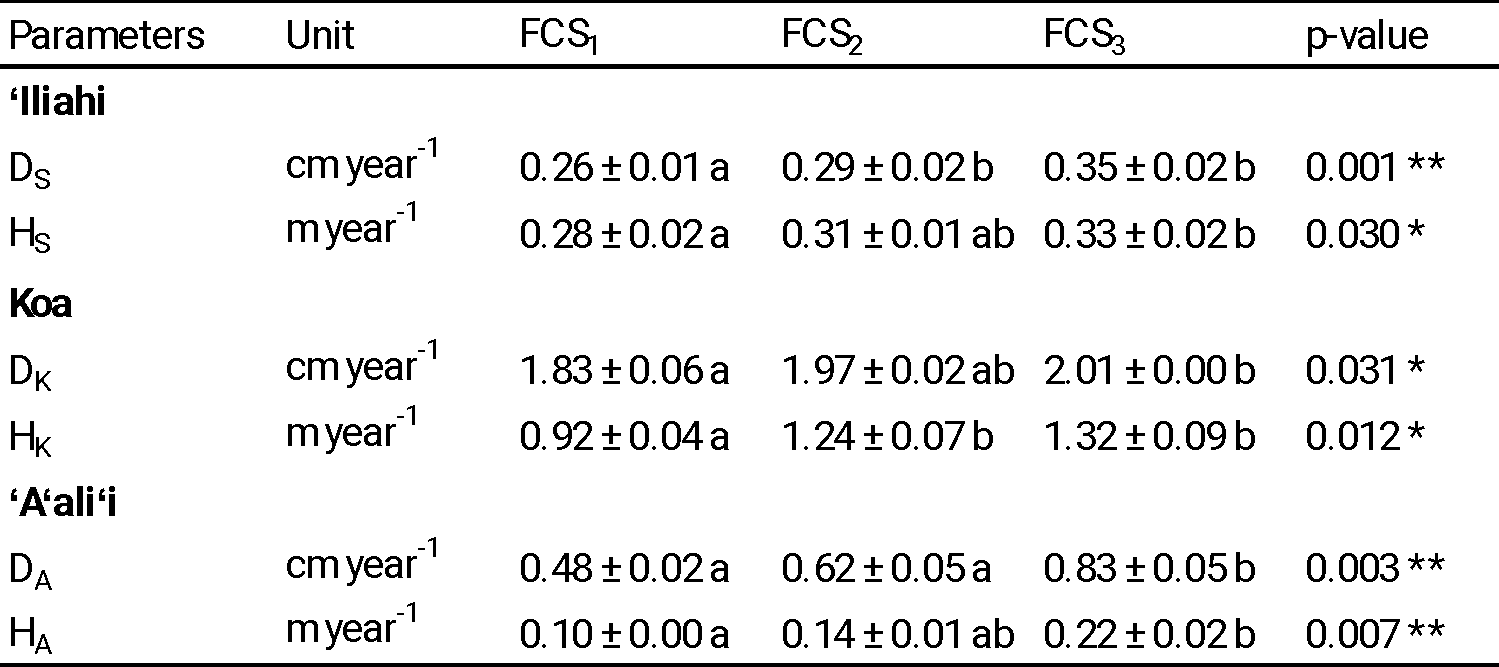
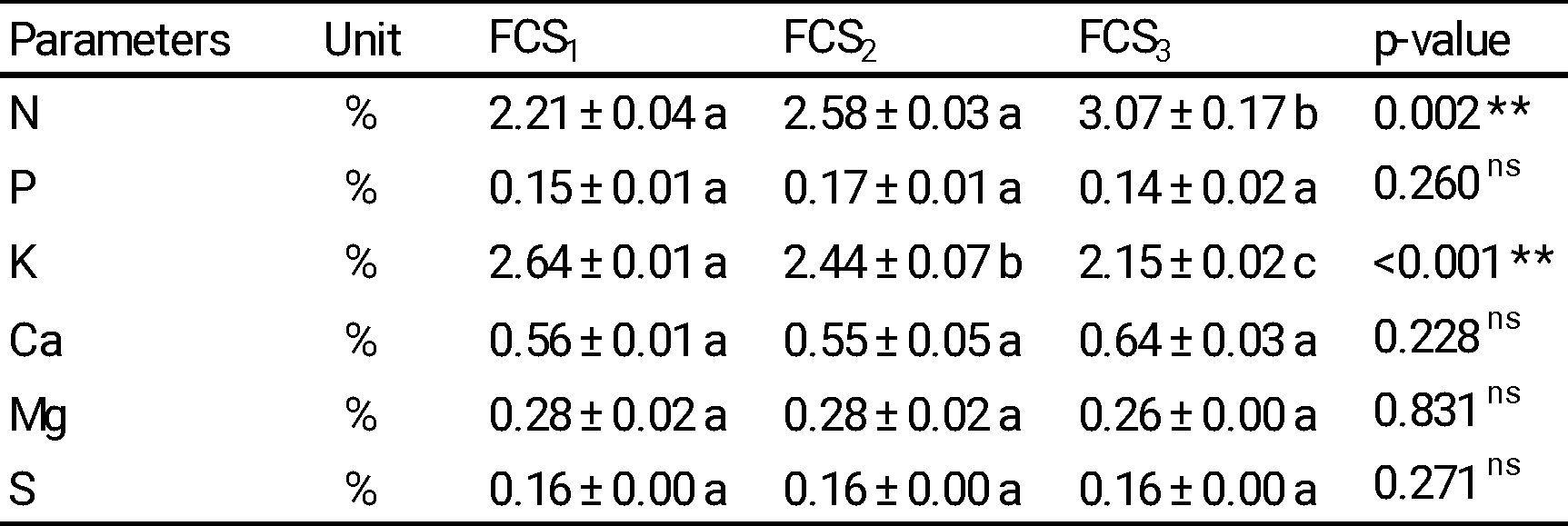

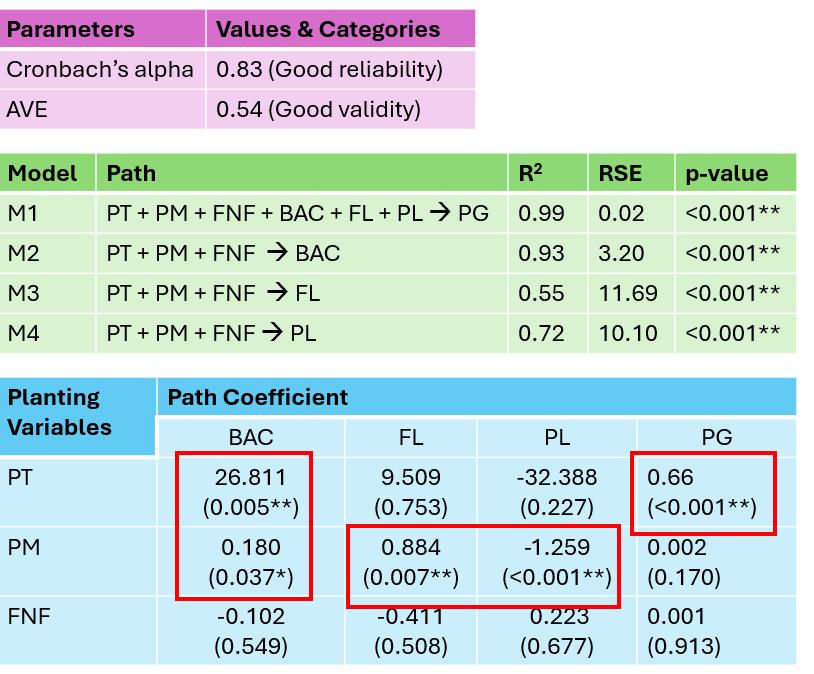
Factors Limiting ʻIliahi Growth
The developed model indicated a good fit to explain the relationship between biotic interactions and the growth of ‘iliahi (Table 4). Planting time (PT) and planting mixture (PM) were the most important factors for growth of ‘iliahi (PG) (Table 5). However, the relative contribution of both factors were substantially different. PT directly affects growth while PM affects growth through indirect relationship by determining the level of competition, facilitation, and parasitism. Pre-established host before planting ‘iliahi offered better growth of ‘iliahi since it can support early stage of root parasitic connection. However, we also also need to maintain the host abundance more than ‘iliahi to stabilize facilitation and parasitism for better ‘iliahi growth.
Future plans
We set up a thinning experiment in Summer 2024 to evaluate the effect of canopy openness improvement on the site of ‘iliahi underplanting to increased the growth of ‘iliahi saplings. Periodic monitoring will be conducted to assess the effectiveness of this treatment at least 2-3 years to understand the short and long term effect of competition reduction to the ‘iliahi growth. Then, we will compile all results to develop a stand dynamic models for mixed native forest stand with hemiparasitic species as basis information for sustainable yield regulation.
Partners / collaborators
Kealakekua Mountain Reserve

